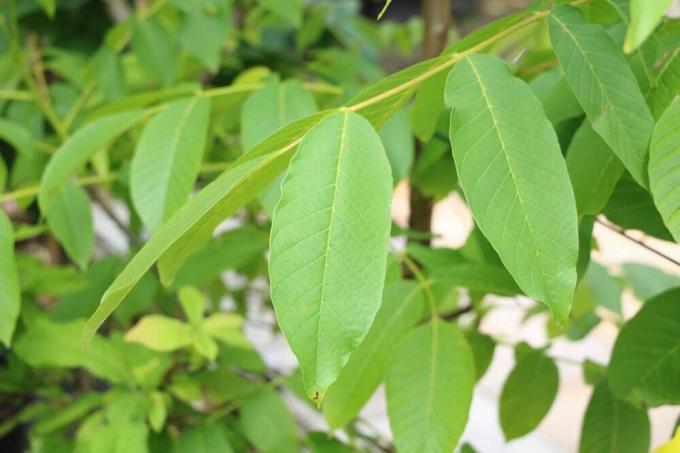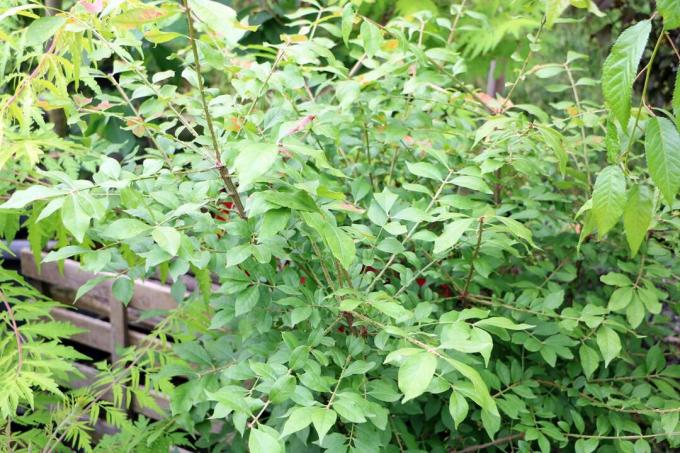

Table of contents
- Growth heights of walnut trees
- Dwarf varieties significantly smaller
- Average growth per year
- Factors influencing growth
- Plant height dependent on variety
- age of the tree
- trunk circumference
- texture of the soil
- stock density
- Features of the cut
- Thin out or shorten?
The walnut tree is one of the oldest known tree species. Almost all parts and the nuts are the purest garden pharmacy. In addition, its tannin-rich leaves can keep unloved insects away. For most, however, the nuts are the main reason for planting a walnut tree. In terms of growth height, a distinction is made between large and small varieties. But how powerful can such a tree actually get?
Growth heights of walnut trees
The real walnut (Juglans regia) is a deciduous, sprawling and fast-growing tree. In the course of its life, under favorable conditions, it can acquire stately proportions, both in height and in width of the crown.
- Walnut can reach heights of growth of 25-30 m
- Trunk develops, depending on the variety, diameter of up to 200 cm
- The broad, round crown can reach dimensions between 10 and 15 m
- Walnut tree develops deep taproots
- The root system is also clearly spreading
- Dimensions of the root can exceed that of the crown
If you want to plant a walnut tree, you should plan an area of 70 to 120 m2, depending on the variety, even if it appears relatively slender at first. In the meantime, there are also breeds that are significantly smaller in growth and are therefore also well suited for smaller gardens and sometimes even for larger tubs.
Dwarf varieties significantly smaller

In contrast to the usual stately walnut trees with their imposing shape, dwarf varieties grow more slowly and compactly. They remain significantly smaller and their crown is less pronounced. So you don't have to do without walnuts even if you have little space. When fully grown, small varieties usually do not grow higher than 400-600 cm and reach a crown diameter of 200-400 cm. Nevertheless, these trees also bear fruit, as they are usually self-pollinating.
Tip:
Good short-growing varieties are e.g. B. the Weinsberger walnut, the bush nut from Finkenwerder and the varieties Lara, Europa, Dwarf Karlik (R) and Mini Multiflora No.14.
Average growth per year
- Noticeable differences between seedling plants and cultivars
- Seedlings grown from nuts grew slower
- Little growth evident in the first and second year
- From the third year, the growth rate increases significantly
- Is now between one and two meters per year
- Growth rate of cultivars, depending on the variety
- Early and rich bearing grow rather slowly
- Others have an annual growth rate of between 50 and 100 cm
- Largest increase occurs between the 10th and 30 standing year
- During this time the walnut tree grows fastest
Later, growth slows down again and concentrates mainly on the width of the crown and the development of the fruit. Around the age of 40 Year crown growth decreases again. Height growth is complete at around 70 to 80 years of age. As a rule, the yields then also drop somewhat. In the case of small or For dwarf varieties, the annual growth rate is between 10 and 20 cm.
Tip:
A walnut tree grown as a seedling bears fruit for the first time after 10-15 years at the earliest, while cultivars after four to six years.
Factors influencing growth

How tall a walnut tree can ultimately grow depends on various factors. The type and age of the tree as well as the trunk circumference, the soil conditions and the stock density can have a positive or negative influence on the growth behavior of the walnut tree.
Plant height dependent on variety
The size of a walnut tree and the time it takes to grow can vary greatly from variety to variety. There are small varieties such as the 'Nut von Chatenay' with a growth height of up to four meters and medium-tall walnut varieties such as e.g. B. Juglans regia 'Weinsberg 1', the growth height of approx. can reach seven meters. Both are well suited for smaller areas in the garden. In contrast, there are medium-growing specimens such as the 'Red Danube Nut', which can reach a height of up to 12 m grows and fast-growing, such as the Kurmarker walnut (No. 1247), which sprout early, with sizes between 15 and 25 m.
age of the tree
- Age of the tree has a significant impact on growth
- Growth was rather irregular and small in the first few years
- Growth usually not even 20 cm per year
- Usually even far below that
- In the years that follow, he easily gains between one and two meters
- Growth from the 10th Stand year more even and constant
- Now grows between 50 and 100 cm a year
- Baum has with approx. reached its maximum height and width at the age of 80 years
trunk circumference
The respective trunk diameter also has an influence on the growth of these trees. Responsible for this are the so-called vascular bundles, which run in the bark and supply the tree with water and nutrients through the capillary effect. The more space these vascular bundles have, the better the tree is supplied, which in turn promotes growth in height and width. In older specimens, from a growth height of around 25 m, this capillary effect is usually no longer sufficient, growth stagnates and the tree has reached its maximum size.
texture of the soil
Another factor that influences growth is soil quality. For example, if the tree is on poorly ventilated soil that tends to waterlogging or is too sandy, this can definitely impair its growth. It grows more slowly and fruit production also suffers. On the other hand, a calcareous loam or clay soil can contribute to optimal growth conditions and yields. In general, the walnut tree feels most comfortable on acidic to neutral soils. Soils with an alkaline pH are also tolerated.
stock density

The height that this tree can reach also depends on whether it stands alone or in a stand of several trees. Solitary specimens usually do not exceed 20 m in height, while trees in the middle of a dense stand can grow up to 30 m in height. This is because in denser stands they literally push themselves up towards the light and can therefore grow larger. However, this only affects the growth in height and not the growth in width of the crown, which is then usually less.
Features of the cut
Pruning the walnut is actually only popular if it has grown too sprawling and takes up too much space. However, the aim of pruning measures should always be to preserve the species-typical shape of the tree. The most important thing here is the correct cutting time. It is in late summer or August September. During these two months, the sap flow is very weak as the tree prepares for hibernation. In addition, the cuts can heal before winter, at least the smaller ones. If this time is missed, for whatever reason, a winter cut is also possible from mid-December to mid-January. This late cut has the advantage that the walnut no longer bleeds because the flow of juice has come to a standstill.
Thin out or shorten?
The walnut tree reacts to the shortening of individual side shoots with stronger budding. If you don't want that, it's better to make a clearing cut. This gives the tree the opportunity to build up a loose crown over the next few years. If the crown is too powerful or too sprawling, a thinning cut is usually not sufficient, so that the outer shoots have to be shortened.
- When thinning out, cut out some of the crown branches up to the trunk
- To reduce the diameter of the crown, shorten shoots
- Cut back every second shoot in the first year
- To the level of a fork, by a maximum of 150 cm
- Next year, cut back the remaining shoots
- Also remove diseased and dead wood
- Absolutely avoid pruning in early spring
- Sap flow is at its strongest at this time
- Tree would be weakened but not die
 garden editorial
garden editorial I write about everything that interests me in my garden.
Learn more about trees & shrubs

Spindle tree (euonymus): care from A to Z
Spindle trees are very popular because of their abundance of flowers. Although they are considered very undemanding, some details should be considered when caring for them.

Golden Elm: Care Instructions | 6 cutting tips
From spring to autumn, the golden elm Ulmus hollandica 'Wredei' boasts a unique foliage colour. With its slender growth, it finds space in every garden and sets colorful accents.

Sloe hedge: plant and cut properly
Planting a sloe hedge and trimming it properly is relatively easy with the right knowledge. Because the sloe is easy to care for and at the same time useful for humans and animals. Here you can find out what to look out for when it comes to care.

pruning yew tree | 15 tips for yew rejuvenation
The yew (Taxus) impresses with numerous properties. To ensure that it grows old healthily and develops magnificently in the long term, it needs to be pruned occasionally. Above all, a taper cut is of great importance. With the right tips, it's easy.

Beech - Instructions for care and pruning
Beeches (Fagus) are not only known from forests, public facilities or parks. The beech tree is also becoming increasingly popular in your own garden. Maintenance is pretty easy here. The cut should be carried out according to the instructions so that the tree can freely develop its original growth.

When does rhododendron bloom? | Beginning and duration of the flowering period
A blooming rhododendron bush casts a spell over everyone. The beautiful flowers, which sometimes appear delicate, sometimes strong pink, violet or even yellow, white or orange, have a very special charm. If you think you can only enjoy this look in spring, you are wrong. The plant is incredibly diverse. Some bushes unfurl their flowers early, while others add color to the gardens in late summer.
